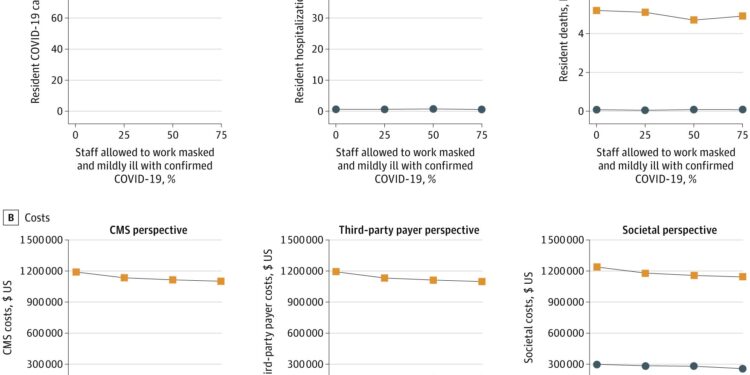Estimated impact of nursing home staff leave policies relative to current staffing levels on COVID-19-related and non-COVID-19-related resident outcomes and costs. Credit: Opening of the JAMA network (2024). DOI: 10.1001/jamanetworkopen.2024.29613
Sending home nurses mildly ill with COVID-19 could lead to unnecessary hospitalizations, deaths and costs for patients, according to a study published in Opening of the JAMA network.
When nursing home staff who test positive for COVID-19 are sent home, it can exacerbate an existing understaffing problem, leading to even more missed resident care tasks, resident hospitalizations and deaths, and costs, the study authors said.
The computer simulation modeling study was conducted by researchers from the Public Health Informatics, Computational, and Operations Research (PHICOR) at CUNY SPH, the Center for Transformative Geriatric Research at Johns Hopkins University School of Medicine, the California Association of Long Term Care Medicine, and the Division of Infectious Diseases at the University of California, Irvine.
Many nursing homes are currently understaffed. A previous study found that 94% of U.S. nursing homes were understaffed in 2021, and 72% of them had fewer staff in 2024 than they did before the pandemic. Reasons for the understaffing include low employee wages, difficult working conditions, staff turnover and burnout, and a lack of minimum staffing standards.
This new modeling study estimates that in the absence of COVID-19, 22% of resident care tasks were not completed given current staffing levels, with an average of 93.7 of 424 daily resident tasks not completed (34,185 missed care tasks per year).
Each year, these missed tasks resulted in an average of 38 resident hospitalizations and 4.6 deaths per 100 nursing home beds, costing the Centers for Medicare and Medicaid Services (CMS) an average of $1.07 million.
Throughout the COVID-19 pandemic, national guidance has been to send employees who test positive for COVID-19 home for up to 10 days (or until the test is negative) to reduce the spread of the virus. This study found that sending staff home worsened staff shortages, with 649.5 more missed tasks per year (1.8 more per day), even when some tasks were performed by other staff in the care home.
These additional missed tasks resulted in an average of 4.3 additional hospitalizations and 0.66 deaths due to staff being sent home. Combined, COVID-19-related hospitalizations and deaths and these missed tasks cost an additional $247,090. However, costs due to the negative health effects of missed care tasks exceeded costs due to COVID-19 by 4.1 to 9.3 times.
A possible temporary alternative to sending them home would be to have only those with mild symptoms work and have them wear N95 respirators.
For example, the study found that when 75% of mildly ill staff worked wearing N95 respirators, there were an average of 240 fewer days of work missed per year, 475.9 additional tasks completed, 3.5 fewer hospitalizations related to missed tasks and 0.4 fewer deaths compared to when all staff were sent home.
However, there were five new COVID-19 cases among residents, but no additional COVID-19-related hospitalizations. Overall, allowing mildly ill staff to work while wearing an N95 mask saved an average of $85,470 per year. These missed work costs consistently outweighed COVID-19 costs when mildly ill staff worked while wearing an N95 mask.
“Although our study shows that allowing mildly ill staff to work while wearing N95 respirators mitigates staffing shortages due to COVID-19-related unpaid leave and reduces unnecessary harm, employees should not be encouraged to work when they are sick and contagious,” said lead author Bruce Y. Lee, CUNY SPH professor and executive director of PHICOR.
“We need to find ways to address the underlying problem of staff shortages, for example by offering competitive salaries.”
More information:
Sarah M. Bartsch et al., Modeling Harm to Nursing Homes from COVID-19-Related Staff Leave Policies, Opening of the JAMA network (2024). DOI: 10.1001/jamanetworkopen.2024.29613
Provided by the City University of New York
Quote:Sending home staff who test positive for COVID-19 means worse outcomes for patients, study finds (2024, September 25) retrieved September 25, 2024, from
This document is subject to copyright. Apart from any fair dealing for the purpose of private study or research, no part may be reproduced without written permission. The content is provided for informational purposes only.



